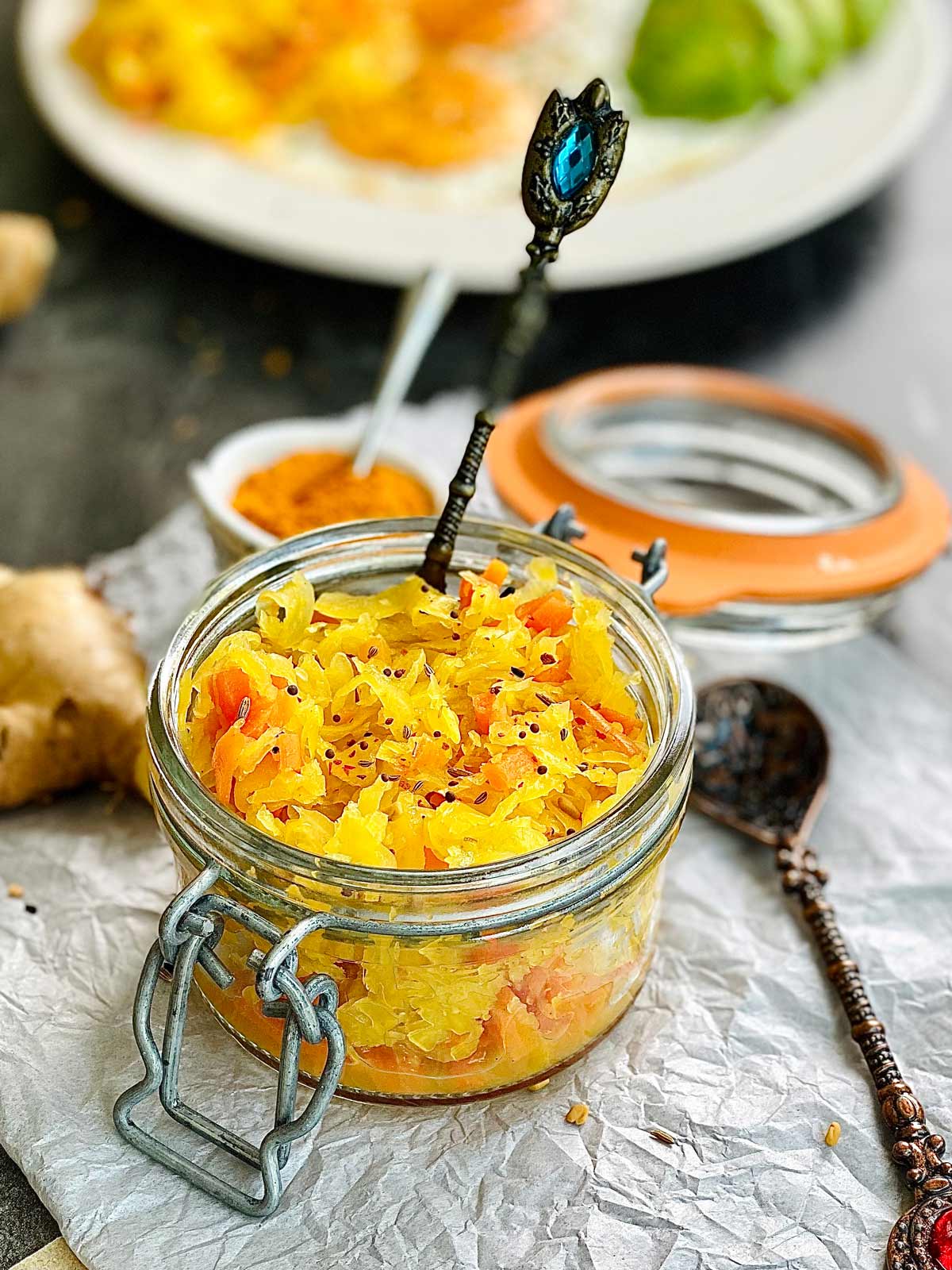Sauerkraut - Fermented Cabbage
Get the ingredients right; Get the process right; Get the right result. Every time.
Sauerkraut Microbiology
Sauerkraut, the beloved tangy cabbage dish, holds a secret within its fermenting depths – a bustling microbial community that transforms humble ingredients into a flavorful probiotic powerhouse.
At the heart of sauerkraut’s magic lies the orchestration of lactic acid bacteria (LAB). Strains like Lactobacillus plantarum, Lactobacillus brevis, and Pediococcus pentosaceus work harmoniously to ferment cabbage into its tangy glory.
Ingredient Variations
From traditional cabbage and salt to creative twists like adding caraway seeds, juniper berries, or apples, the ingredients in sauerkraut recipes offer diverse microbial ecosystems. Each variation introduces unique flavors and textures, courtesy of the evolving microbial community.
The Fermentation Waltz
As the lactobacilli perform their fermentation waltz, they create an acidic environment that preserves the sauerkraut while unlocking its probiotic potential. It’s a microbial dance that elevates cabbage to a tangy delight, showcasing the flavorful synergy between science and tradition.



Sauerkraut Recipe + Process
Sourkraut is very simple. At its core, it’s literally just cabbage and salt.
Prepare the Cabbage: Start with fresh cabbage. Remove any damaged outer leaves. Rinse the cabbage under cold water and then quarter and core it.
Slice or Shred: Slice the cabbage thinly or shred it using a knife or a mandoline slicer. The finer the cuts, the easier it is for the cabbage to ferment.
Add Salt: Place the sliced cabbage in a large mixing bowl and sprinkle it with salt. The salt helps draw out moisture from the cabbage and starts the fermentation process. Use about 1.5-2% of salt by weight compared to the cabbage.
Massage and Extract Juices: With clean hands, massage the salt into the cabbage. Continue massaging for about 5-10 minutes until the cabbage starts to soften and releases its juices. This step is crucial for creating the brine.
Pack into a Jar: Transfer the cabbage and its juices into a clean glass jar or fermentation crock. Pack the cabbage tightly into the container, pressing it down to remove any air pockets.
Weight and Submerge: Place a weight, like a smaller jar filled with water or a purpose-made fermentation weight, on top of the cabbage to keep it submerged under its liquid. The cabbage should be fully covered with the brine.
Fermentation: Seal the jar loosely to allow gases to escape and place it in a cool, dark place (around room temperature) to ferment. Check in after a week, then taste periodically until it reaches your desired level of tanginess, usually around 2-4 weeks.
Refrigerate: Once the sauerkraut has reached the desired flavor, move it to the refrigerator to slow down the fermentation process. Enjoy it as a flavorful and probiotic-rich addition to your meals!
Ingredients
- Fresh Cabbage
- Salt
Supplies
- Container with Lid
- Flat, Heavy Weight
- Smasher/tamper





Creative Sauerkraut Variations
Here are a few variations on traditional sauerkraut:
Classic Sauerkraut with Caraway Seeds:
- Follow the traditional sauerkraut recipe but add a tablespoon of caraway seeds along with the salt. Caraway seeds impart a slightly nutty and aromatic flavor to the sauerkraut.
Red Cabbage Sauerkraut:
- Substitute some or all of the green cabbage with red cabbage. This variation not only adds vibrant color but also introduces a slightly different flavor profile.
Spicy Sauerkraut with Chili Peppers:
- Add sliced chili peppers or red pepper flakes to the cabbage and salt mixture for a spicy kick. Adjust the amount based on your heat preference.
Apple and Onion Sauerkraut:
- Mix grated apple and thinly sliced onion with the cabbage before massaging with salt. The sweetness of the apple complements the tanginess of the sauerkraut, while the onion adds depth.
Ginger and Turmeric Sauerkraut:
- Grate fresh ginger and turmeric into the cabbage mixture before packing it into the jar. These spices offer a unique twist and bring a hint of warmth to the sauerkraut.
Kimchi-inspired Sauerkraut:
- Incorporate Korean flavors by adding ingredients like Korean chili powder (gochugaru), garlic, ginger, and grated daikon radish to the cabbage. This variation creates a tangy and spicy sauerkraut similar to kimchi.
Fruit-infused Sauerkraut:
- Experiment with adding fruits like grated pear or pineapple chunks to the cabbage mixture. Fruits can introduce sweetness and complexity to the sauerkraut’s flavor profile.
Remember to adjust the quantities of added ingredients based on personal taste preferences. The fermentation time may vary depending on the ingredients used, so taste the sauerkraut occasionally until it reaches the desired level of tanginess and flavor complexity. Enjoy exploring these flavorful variations!
Ingredients
- Fresh Cabbage
- Salt
Supplies
- Container with Lid
- Flat, Heavy Weight
- Smasher/tamper
F.A.Q.
Sauerkraut, the beloved tangy cabbage dish, holds a secret within its fermenting depths – a bustling microbial community that transforms humble ingredients into a flavorful probiotic powerhouse.
At the heart of sauerkraut’s magic lies the orchestration of lactic acid bacteria (LAB). Strains like Lactobacillus plantarum, Lactobacillus brevis, and Pediococcus pentosaceus work harmoniously to ferment cabbage into its tangy glory.
Ingredient Variations
From traditional cabbage and salt to creative twists like adding caraway seeds, juniper berries, or apples, the ingredients in sauerkraut recipes offer diverse microbial ecosystems. Each variation introduces unique flavors and textures, courtesy of the evolving microbial community.
The Fermentation Waltz
As the lactobacilli perform their fermentation waltz, they create an acidic environment that preserves the sauerkraut while unlocking its probiotic potential. It’s a microbial dance that elevates cabbage to a tangy delight, showcasing the flavorful synergy between science and tradition.

